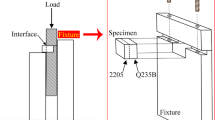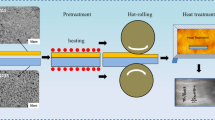Abstract
When the dissimilar metal composite plate accumulates inconsistent deformation to a certain degree during the heat treatment process, it indicates bad plate morphology such as warpage. Therefore, it is crucial to explore the mechanism of coordinated deformation between layers under thermal–mechanical coupling during heat treatment. This study investigates the interlayer coordinated deformation mechanism of the stainless-steel clad plate (304/Q235 stainless-steel clad plate) under thermal–mechanical coupling by using three heat treatment methods: rapid cooling process, rapid cooling in the high-temperature stage + slow cooling in the low-temperature stage, and rapid cooling + tempering process. And this study enlightens that the temperature field distribution and the longitudinal stress–strain distribution are obtained by using the Abaqus software. The effects of different tensile and thickness ratios on the residual stress are analyzed. The final experiment found that the maximum longitudinal stress and plastic strain appear on the upper and lower surfaces during heat treatment. The rapid cooling heat treatment process has light warpage and good shape. When the thickness ratio of the composite plate is 1:4, the warpage is the lightest. The increase of set tension will increase the compressive stress value in the residual stress. In contrast, the tensile stress value will decrease.




















Similar content being viewed by others
Availability of Data and Materials
The [DATA TYPE] data used to support the findings of this study are available from the corresponding author upon request.
References
R. Kosturek, M. Najwer, P. Nieslony, and M. Wachowski, Effect of Heat Treatment on Mechanical Properties of Inconel 625/Steel P355NH Bimetal Clad Plate Manufactured by Explosive Welding, 2018
J.S. Kim, K.S. Lee, N.K. Yong, B.J. Lee, Y.W. Chang, and S. Lee, Improvement of Interfacial Bonding Strength in Roll-Bonded Mg/Al Clad Sheets through Annealing and Secondary Rolling Process, Mater. Sci. Eng., A, 2015, 628, p 1–10
Y. Zheng, Z. Zhang, and Y. Jiang, Effects of Annealing on Microstructure, Composition and Magnetic Properties of Rolled Fe/Ga-Al Composite Strip, J. Magn. Magn. Mater., 2018, 452, p 266–271
G.-Y. Yan, F. Mao, Z.-Q. Cao, T.-J. Li, and T.-M. Wang, Deformation and Heat Treatment Ability of Three-Layer 6009/7050/6009 Al Alloy Clad Slab Prepared by Direct-Chill Casting, Trans. Nonferrous Met. Soc. China (Engl. Edn.), 2018, 28(1), p 1–8
R. Wang, Z.H. Bai, M.X. Zhang, C. Qian, and Y.X. Wang, Comprehensive Optimisation Technology of Roller Profile in Continuous Annealing Furnace, Ironmak. Steelmak., 2018, 45(6), p 519–522
N. Jacques, A. Elias, M. Potier-Ferry, and H. Zahrouni, Buckling and Wrinkling during Strip Conveying in Processing Lines, J. Mater. Process. Technol., 2007, 190(1–3), p 33–40
K. Kpogan and M. Potier-Ferry, Buckling of Long Thin Plates under Residual Stresses with Application to Strip Rolling, Key Eng. Mater., 2014, 611–612, p 221–230
A.V. Nishchik, S.V. Yashchuk, O.N. Baklanova, and I.G. Rodionova, Effect of Treatment Temperature Regimes in a Continuous Annealing Unit on Two-Phase Ferritic-Martensitic Steel Mechanical Properties, Metallurgist, 2016, 60(5–6), p 594–601
L. Xingfu, Research on the Deformation Behavior of Plate Shape and Warping, Beijing University of Science and Technology, Beijing, 2015.
Z. Qingdong, L. Xingfu, and Z. Xiaofeng, Research on the Warping Deformation Behavior of Apparent Flat Strip After Cutting, Eng. Mech., 2014, 31(S1), p 217–222
Z. Qingdong, L. Xiao, L. Jiyang, and H. Shushan, Research on Finite Element Numerical Simulation Model of Q&P Steel Heat Treatment Process, J. Met., 2019, 55(12), p 1569–1580
Y. Wei and W. Yifa, Relationship Between Cooling Parameters and Warpage of Hot Rolled Strip, J. Eng. Sci., 2016, 38(12), p 1734–1740
R. Hino, Y. Goto, and F. Yoshida, Springback of Sheet Metal Laminates in Draw-Bending, J. Mater. Process. Technol., 2003, 139(1–3), p 341–347
R. Wang, Z.H. Bai, J.C. Du, Y.X. Wang, Y.Y. Cui, Z.S. Guo et al., Comprehensive Tension Setting Optimisation Technique for a Cold Rolled Strip during Continuous Annealing, Ironmak. Steelmak., 2018, 45(6), p 523–527
Z.H. Bai, R. Wang, J.C. Du, Y.X. Wang, Y.X. Liu, Y.Y. Cui et al., Modelling of Strip Buckling in the Continuous Annealing Process, Ironmak. Steelmak., 2017, 44(10), p 782–788
R. Sun, Y. Shi, Z. Pei, Q. Li, and R. Wang, Heat Transfer and Temperature Distribution during High-Frequency Induction Cladding of 45 Steel Plate, Appl. Therm. Eng., 2018, 139, p 1–10
W. Shangqun, Simulation of Hot Rolling of Stainless Steel Clad Plate, Yanshan University, Qinghuangdao, 2015.
G. Fei, Study on Residual Stress of Dissimilar Steel Welding, Dalian University of Technology, Dalian, 2010.
Y. Shiming, Heat Transfer Theory, Higher Education Press, Beijing, 2006.
G.R. Johnson and W.H. Cook, Fracture Characteristics of Three Metals Subjected to Various Strains, Strain Rates, Temperatures and Pressures, Eng. Fract. Mech., 1985, 21(1), p 31–48
Z. Dujiang, Z. Zhenyu, He. Liang, R. Jianwei, Q. Lusheng, and Z. Yilai, Calibration and Verification of Dynamic Mechanical Properties Parameters of High-Strength Armor Steel Based on Johnson-Cook Constitutive Model, J. Mil. Eng., 2022, 43(08), p 1966–1976
Acknowledgments
The authors would like to acknowledge the financial support provided by the National Natural Science Foundation of China (Grant No. 51305241), National Natural Science Foundation of China (Grant No. 51705295), Natural Science Foundation of Shandong Province (CN) (ZR2018MEE022), and Youth Innovation Team Development Plan of Colleges and Universities in Shandong Province (2019KJB015).
Author information
Authors and Affiliations
Contributions
All authors contributed to the study conception and design. Material preparation, data collection and analysis were performed by SC, ZZ, ZG, LS, LY and WR. The first draft of the manuscript was written by SC and all authors commented on previous versions of the manuscript. All authors read and approved the final manuscript.
Corresponding author
Ethics declarations
Conflict of interest
No potential conflict of interest was reported by the authors.
Ethical Approval
I certify that this manuscript is original and has not been published and will not be submitted elsewhere for publication while being considered by The International Journal of Advanced Manufacturing Technology. And the study is not split up into several parts to increase the quantity of submissions and submitted to various journals or to one journal over time. No data have been fabricated or manipulated (including images) to support my conclusions. No data, text, or theories by others are presented as if they were our own.
Additional information
Publisher's Note
Springer Nature remains neutral with regard to jurisdictional claims in published maps and institutional affiliations.
Supplementary Information
Below is the link to the electronic supplementary material.
Rights and permissions
Springer Nature or its licensor (e.g. a society or other partner) holds exclusive rights to this article under a publishing agreement with the author(s) or other rightsholder(s); author self-archiving of the accepted manuscript version of this article is solely governed by the terms of such publishing agreement and applicable law.
About this article
Cite this article
Su, C., Zhang, Z., Zhang, G. et al. Research on Coordinative Deformation Mechanism Between Layers of 304/Q235 Composite Plate under Thermal/Mechanical Coupling. J. of Materi Eng and Perform 33, 1336–1348 (2024). https://doi.org/10.1007/s11665-023-08062-6
Received:
Revised:
Accepted:
Published:
Issue Date:
DOI: https://doi.org/10.1007/s11665-023-08062-6




